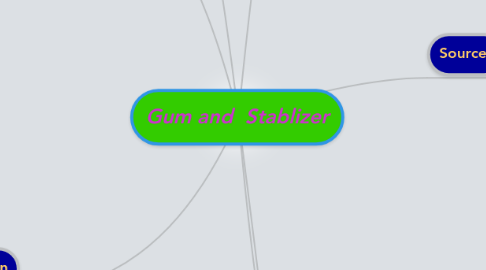
1. Gelation
1.1. Thermally irreversible
1.1.1. Alginate
1.1.1.1. Formed on the addition of polyvalent cation notably calcium or at low pH
1.1.2. Starch
1.1.3. Konjac
1.1.4. HM pectin
1.1.4.1. Formed at high soluble solid content at low pH
1.2. Thermoreversible
1.2.1. Gelatin
1.2.2. Agar
1.2.3. K-carrageenan
1.2.4. i-carrageenan
1.2.5. LM pectin
1.2.6. Gellan gum
1.2.7. Methyl cellulose HPMC
1.3. Form on
1.3.1. Cooling
1.3.1.1. Gelatin
1.3.1.2. Agar
1.3.1.3. Kappa Carrageenan
1.3.1.4. Iota Carrageenan
1.3.1.5. Low methoxyl Pectin
1.3.1.6. Gellan (in presence of salt)
1.3.1.7. Xanthan Gum
1.3.1.8. Locust bean gum ( formed after freezing)
1.3.1.9. Konjac Manna ( addition of alkali)
1.3.2. Heating
1.3.2.1. Methyl cellulose
1.3.2.2. Hydroxypropyl methyl cellulose
2. Ranking of Gum Propeties
2.1. Solution Clarity
2.2. Solubility at various temperature
2.3. Gelling vs Thickening
2.4. Suspension ability
2.5. Acid Stablity
2.5.1. Good
2.5.1.1. Pectin
2.5.1.2. Xanthan
2.5.1.3. Gellan
2.5.1.4. Gum Arabic
2.5.1.5. LBG
2.5.1.6. Tragacanth
2.5.2. Fair
2.5.2.1. Guar
2.5.2.2. PGA
2.5.2.3. Alginate
2.5.2.4. Gelatin
2.5.2.5. Agar
2.5.3. Poor
2.5.3.1. Carrageenan
2.5.3.2. Cellulose derivatives
2.6. Natural vs Not natural
2.7. Ability to stabilize protein at low pH
2.8. Relative cost per unit weight
3. Function
3.1. Primary Function
3.1.1. Thickening Agent
3.1.1.1. Alginate in beverage
3.1.1.2. Locust Bean Gum
3.1.1.3. Cellulose derivatives
3.1.2. Gelling or texturizing agents
3.2. Secondary Function
3.2.1. Stabilisation of emulsion
3.2.1.1. Alginate
3.2.1.2. Gum arabic
3.2.1.3. Locust Bean Gum
3.2.2. Suspension of particulates
3.2.3. Control of crystallisation
3.2.3.1. Alginate
3.2.4. Encapsulation
3.2.4.1. Example Gum Arabic
3.2.5. Formation of Film
4. Vicosity
4.1. temperature
4.1.1. Increased with temperature
4.1.1.1. Methyl cellulose
4.1.1.2. Hudroxypropyl cellulose
4.1.2. Decreased with temperature
4.1.2.1. Galactomannas
4.1.2.1.1. Guar
4.1.2.1.2. Locust Bean Gum
4.2. Addition of electrolyte
4.2.1. Decreased
4.2.1.1. Carboxymethylcellulose
4.2.2. Maintain
4.2.2.1. Xanthan Gum
4.2.3. Not influenced
4.2.3.1. Methyl cellulose
4.2.3.2. hydroxypropyl cellulose
4.3. pH
4.3.1. Low and High
4.3.1.1. Galactomannas
4.3.2. Not influenced
4.3.2.1. Methyl cellulose
4.3.2.2. Hydroxypropyl cellulose
5. Sources
5.1. Animal
5.1.1. Gelatin
5.1.1.1. 2 type
5.1.1.1.1. Type B
5.1.1.1.2. Type A
5.1.1.2. Glycine account 1/3 of all amino acid in gelatin
5.1.1.3. Specialty
5.1.1.3.1. Gives high quality of gel in dilute solution with a clean "melt in mouth " texture
5.1.1.3.2. At high concentration , gives elastic gum like texture which slowly dissolve in the mouth
5.1.1.3.3. Effective emulsifying & Foaming agent
5.1.1.3.4. As a polyelectrolyte
5.2. Plant
5.2.1. Carrageenan
5.2.1.1. Three types
5.2.1.1.1. Kappa
5.2.1.1.2. Lamda
5.2.1.1.3. Iota
5.2.1.2. Manufacturing process
5.2.1.2.1. Selection and cleaning of seaweed for each products
5.2.1.2.2. Decoloration
5.2.1.2.3. Alkaline modification
5.2.1.2.4. Clarification
5.2.1.2.5. Concentration by evaporation
5.2.1.2.6. Precipitation with alcohol or with KCL
5.2.2. Konjac Glucomannan
5.2.3. Locust Bean Gum
5.2.4. Gum Arabic
5.2.5. Pectin
5.2.5.1. High methoxy Pectin
5.2.5.2. Low methoxy pectin
5.2.6. Guar gum
5.2.7. Xanthan Gum
5.2.8. Cellulose derivatives
5.2.8.1. Carboxymethylcellulose
5.2.8.2. methylcellulose
5.2.8.3. Hydroxypropylcellulose
5.2.8.4. Microcrystalline cellulose
5.2.8.5. Carboxymethylcellulose
5.2.9. Starch derivatives
5.2.9.1. Hydroxypropyl starch
6. Classification based on functional properties
6.1. Gelling Agents
6.1.1. Pectin
6.1.2. Carrageenan
6.1.3. Agar
6.1.4. Konjac
6.1.5. Gelatin
6.2. Thickeners
6.2.1. Gum Arabic
6.2.2. Xanthan Gum
6.2.3. Methyl cellulose
6.2.4. Hydroxypropyl cellulose
6.2.5. Galactomannas
6.2.5.1. Guar
6.2.5.2. Locust Bean Gum
6.2.6. Carboxymethylcellulose
7. Main Classes of Hydrocolloids
7.1. Derivatives from exudation or sap of tree
7.2. Extract from
7.2.1. Seed
7.2.1.1. Locust Bean Gum
7.2.1.2. Guar Gum
7.2.1.3. Tare Gum
7.2.1.4. Tamarind Gum
7.2.2. Seaweeds
7.2.2.1. Carrageenan
7.2.3. Tubers
7.2.3.1. Konjac Glucomanna
7.2.4. Plant Parts
7.2.4.1. Pectin from peel of citrus fruits
7.2.4.2. Starch
7.2.4.3. Cellulose
